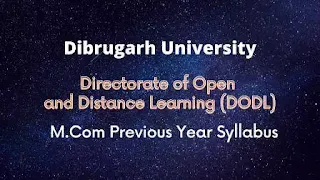Dibrugarh
University M.Com Previous Year Syllabus (DODL)
Subject: Cost and Management Accounting
Course
No.COM-103
Marks-80
Block-I: cost accountancy, Activity based costing and cost Reduction.
Unit-I: cost Accountancy: Objectives, Introduction ,Definition of cost, costing and cost Accounting ;nature of cost Accounting, objective of cost accounting, Importance of cost Accounting, Evolution of cost Accounting system and cost concepts.
Unit-II: Activity
Based costing: Objectives ,Weaknesses of
conventional costing, meaning of Activity based costing,
Stages and Flow of costs in Activity Based costing,
cost Analysis under Activity Based costing
,Differences between Activity Based costing and
conventional costing, Scope of Activity Based costing
,benefits and Limitations of Activity Based costing,
Installation of Activity Based costing .
Unit-III: cost
Reduction: Objectives, Meaning of cost Reduction, cost
control and cost Reduction ,objectives of cost Reduction
,principles of cost Reduction and control, scope and areas of
cost control and cost Reduction, Distinction between cost control
and cost Reduction Techniques to control and Reduce costs,
Advantages of cost Reduction, Dangers of cost Reduction
Efforts, cost Reduction-its organization.
Block-2: operating costing, process costing and reconciliation of cost and Financial Accounts.
Unit – I: Operating
costing: Objectives, concept of operating costing,
transport costing –objectives, composition of costs
,Ascertainment of costs, Illustration 1 to 5.
Unit-II: process
costing: Objectives ,process costing, Introduction, Applicability of
process costing, Essential characteristics of process costing
,Distinction between job costing and process costing, General
principles of process costing ; Illustration-I. Normal process Loss:
Illustration-2, Abnormal process Loss: Illustration-3, Abnormal Gain/Effectiveness:
Illustration-4, Inter –process profit: Illustratin-5. By –product and its
accounting treatment: illustration-6, joint products and their accounting treatment;
Illustration-7.
Unit-III: Reconciliation of
cost and financial Accounts: Objectives, Introduction,
objectives of Reconciliation, Need for Reconciliation, Reasons for
disagreement between cost Accounts and financial Accounts,
Differing Treatment of items, Effects of various items on profit,
procedure of Reconciliation, Illustration-1 to 5.
Block-3: Analysis and Interpretation of Accounts; Study of financial statements; Techniques of financial statement analysis.
Unit-I: Analysis
and Interpretation of Account: Objectives, meaning of
financial statement analysis, objectives of financial statement
analysis, Interpretation of financial statement, practices
interested in financial statement Analysis.
Unit-II: Analysis and Interpretation of Accounts: Objectives,
meaning of financial statement Analysis, Interpretation of financial
statement, parties interested in financial statements, Limitations of
financial statement Analysis, procedure for interpretation.
Unit-III: Study
of financial statement ;Techniques of financial statement Analysis: Objectives,
Techniques of financial statement Analysis
–Horizontal Analysis, Vertical Analysis, trend Analysis
,Ratio- Analysis, comparative financial Statements ,and Common-size
statements.
Block-4: Analysis and Interpretation of financial data; Ratio Analysis
Unit-I: Analysis
and Interpretation of financial Data: Objectives
,Meaning ,purpose and need for Ratio Analysis, Advantages of
ratio Analysis, Limitations of Ratio Analysis.
Unit-II: Ratio Analysis: Objectives,
Different modes of expressing ratios, Balance sheet Ratio,
Revenue Ratio, and Composite Ratios. Functional or
purpose classification of Ratio-Liquidity Ratio, Leverage Ratio,
profitability Ratio, activity ratios.
Also Read: Dibrugarh University DODL (M.Com Previous Year Syllabus)
102 - Organisational Behaviour and Theory
103 - Cost and Management Accounting
104 - Entrepreneurship Development
Block-5: Working capital : concept and management ; projection of working capital requirements .
Unit-i: Working
capital –concept and management, Objectives ,meaning of
working capital ,concept of working capital, Importance
of working capital, factors affecting the amount
of Working capital, classification of working capital, working capital
cycle.
Unit-II: projection of working
capital requirements; in case of Trading organization –in
case of Manufacturing organization . Objectives, estimating Working capital
requirements -manufacturing concerns, illustrations.

